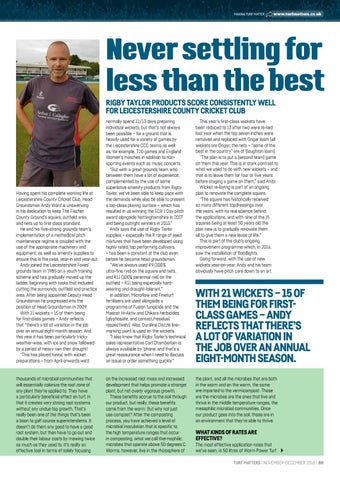making turf matter
www.turfmatters.co.uk
Never settling for less than the best
RIGBY TAYLOR PRODUCTS SCORE CONSISTENTLY WELL FOR LEICESTERSHIRE COUNTY CRICKET CLUB
Having spent his complete working life at Leicestershire County Cricket Club, Head Groundsman Andy Ward is unswerving in his dedication to keep The Fischer County Ground’s square, outfield area and nets up to first class standard. He and his five-strong grounds team’s implementation of a methodical pitch maintenance regime is coupled with the use of the appropriate machinery and equipment, as well as amenity supplies to ensure this is the case, year-in and year-out. Andy joined the Leicestershire Foxes’ grounds team in 1985 on a youth training scheme and has gradually moved up the ladder, beginning with tasks that included cutting the surrounds, outfield and practice area. After being appointed Deputy Head Groundsman he progressed into the position of Head Groundsman in 2009. With 21 wickets – 15 of them being for first-class games – Andy reflects that “there’s a lot of variation in the job over an annual eight-month season. And this year it has been particularly tricky weather-wise, with ice and snow followed by a period of heavy rain then drought! “This has played havoc with wicket preparations – from April onwards we’d
normally spend 12/13 days preparing individual wickets, but that’s not always been possible – for a ground that is heavily used for a variety of games by the Leicestershire CCC teams as well as, for example, T20 games and England Women’s matches in addition to nonsporting events such as music concerts. “But with a great grounds team who between them have a lot of experience, complemented by the use of some superlative amenity products from Rigby Taylor, we’ve been able to keep pace with the demands while also be able to present a top-class playing surface – which has resulted in us winning the ECB 1 Day pitch award alongside Nottinghamshire in 2017 and being outright winners in 2013.” Andy says the use of Rigby Taylor supplies – especially the R range of seed mixtures that have been developed using highly rated, top performing cultivars – has been a constant at the club even before he became head groundsman. “We’ve always used R9 (100% ultra-fine rye) on the square and nets, and R11 (100% perennial rye) on the outfield – R11 being especially hardwearing and drought-tolerant.” In addition, Microflow and Fineturf fertilisers are used alongside a programme of Fusion fungicide and the Mascot Hi-Aktiv and Chikara herbicides (glyphosate, and contact/residual, respectively). Also, Duraline Dazzle linemarking paint is used on the wickets. ”I also know that Rigby Taylor’s technical sales representative Carl Chamberlain is always available by ‘phone, and that’s a great reassurance when I need to discuss an issue or order something quickly.”
thousands of microbial communities that will essentially colonize the root zone of any plant they’re applied to. They have a particularly beneficial effect on turf, in that it creates very strong root systems without any undue top growth. That’s really been one of the things that’s been a boon to golf course superintendents. It doesn’t do them any good to have a good root system, but then have to go out and double their labour costs by mowing twice as much as they used to. It’s really an effective tool in terms of solely focusing
on the increased root mass and increased development that helps promote a stronger plant, but not overly vigorous growth. These benefits accrue to the soil through our product, but really, these benefits come from the worm. But why not just use compost? After the composting process, you have achieved a level of microbial inoculation that is specific to the high temperature ranges that occur in composting, what we call thermophilic microbes that operate above 50 degrees C. Worms, however, live in the rhizosphere of
This year’s first-class wickets have been reduced to 13 after two were re-laid last year when the top seven inches were removed and replaced with Ongar loam [all wickets are Ongar; the nets – “some of the best in the country” are of Boughton loam]. “The plan is to put a (second team) game on them this year. This is in stark contrast to what we used to do with new wickets – and that is to leave them for four or five years before staging a game on them,” said Andy. Wicket re-laying is part of an ongoing plan to renovate the complete square. “The square has historically received so many different topdressings over the years, with no real science behind the applications, and with nine of the 15 squares being at least 50 years old the plan now is to gradually renovate them all to give them a new lease of life.” This is part of the club’s ongoing improvement programme which, in 2016, saw the installation of floodlights. Going forward, with the use of new wickets year-on-year, Andy and his team obviously have pitch care down to an art.
With 21 wickets – 15 of them being for firstclass games – Andy reflects that there’s a lot of variation in the job over an annual eight-month season. the plant, and all the microbes that are both in the worm and on the worm, the same are imparted to the vermicompost. Those are the microbes are the ones that live and thrive in the middle temperature ranges, the mesophilic microbial communities. Once our product goes into the soil, those are in an environment that they’re able to thrive.
What kinds of rates are effective? The most effective application rates that we’ve seen, is 50 litres of Worm Power Turf } Turf Matters | NOVEMBER-DECEMBER 2018 | 69
